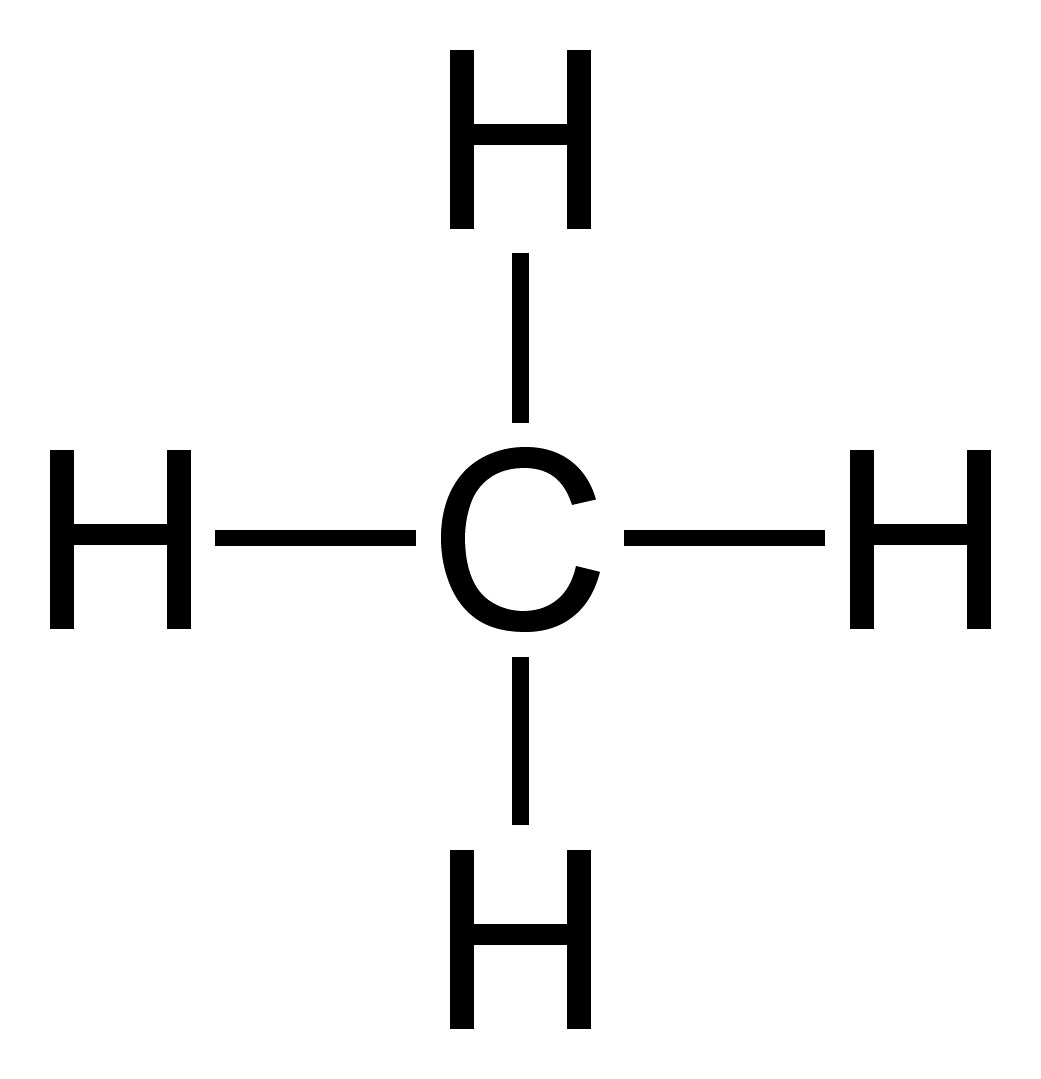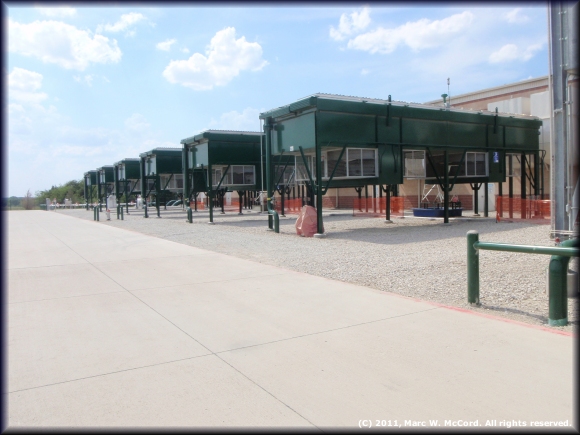Greenhouse Gases
Possible New Catalyst for Methane Capture in Cars and Gas Field
 Via Chemical and Engineering News comes word that scientists from the University of Pennsylvania and the University of Trieste in Italy have developed a new low-temperature catalyst material that could remove methane emissions form vehicles as well as many different gas and oil field facilities. It would work the same way your car's catalytic converter works now – you force the emissions through a cylinder web or screen coated with a chemical designed to pick up specific molecules.
Via Chemical and Engineering News comes word that scientists from the University of Pennsylvania and the University of Trieste in Italy have developed a new low-temperature catalyst material that could remove methane emissions form vehicles as well as many different gas and oil field facilities. It would work the same way your car's catalytic converter works now – you force the emissions through a cylinder web or screen coated with a chemical designed to pick up specific molecules.
In the past, this process didn't work with Methane until you reached higher temps than are usually found in a car's engine. The breakthrough being reported solves that problem by allowing the capture of methane to take place at lower temperatures. Still in the testing phase, but we need to be on the lookout for better ways to capture methane pollution, which has been found to be something like 26 times more destructive to climate change per ton as CO2.
"Edman Tsang of Oxford University, an expert on catalysis and clean energy, says: “There is a tremendous need to remove small amounts of methane from the exhausts of gas turbines and internal combustion engines and from flue gases in petrochemical and related industries. The generally low activity of conventional catalysts and their instability at high temperatures” have made it difficult to meet this challenge, whereas the new catalyst makes a first step toward a solution. The approach needs further assessment but provides “a clear direction” for future research, he says."
” A stunning increase in the frequency of extremely hot summers”
 That's James Hansen and other researchers' conclusion after looking at the past 60 years of thermometer readings from Mother Earth. They use last year's $5 billion drought here in Texas as a vivid example of the kind of thing that used to be rare, but no longer is, and they lay the blame squarely on human-made pollution.
That's James Hansen and other researchers' conclusion after looking at the past 60 years of thermometer readings from Mother Earth. They use last year's $5 billion drought here in Texas as a vivid example of the kind of thing that used to be rare, but no longer is, and they lay the blame squarely on human-made pollution.
"This is not a climate model or a prediction but actual observations of weather events and temperatures that have happened. Our analysis shows that it is no longer enough to say that global warming will increase the likelihood of extreme weather and to repeat the caveat that no individual weather event can be directly linked to climate change. To the contrary, our analysis shows that, for the extreme hot weather of the recent past, there is virtually no explanation other than climate change."
Wasting No Time, Texas Rushes To Apply Health Care Ruling to EPA “Mandates”
 A huge national law firm that the State of Texas has hired to represent it in various facets of its anti-EPA jihad has taken the rhetoric of the recent Supreme Court decision and is now attempting to apply it to federal environmental mandates.
A huge national law firm that the State of Texas has hired to represent it in various facets of its anti-EPA jihad has taken the rhetoric of the recent Supreme Court decision and is now attempting to apply it to federal environmental mandates.
According to an Energy and Environment article from last week,
"The focus for now is on part of the health care decision in which the court held, on a 7-2 vote, that the federal government cannot take away all of a state's Medicaid funding if it declines to implement new provisions that were introduced under the reform law. The court saw such a move as akin to coercion.
Congress cannot "penalize states that choose not to participate in that new program by taking away their existing Medicaid funding," Chief Justice John Roberts wrote in the majority opinion.
Lawyers at the Baker Hostetler law firm, which represents Texas, were clearly paying attention to the academic debate that immediately broke out, in which some scholars saw similarities between the Medicaid provisions in the health care law and how the federal government interacts with states over their role in enforcing the Clean Air Act via state implementation plans, known as SIPs."
Most legal scholars don't believe this will go anywhere, but this move is just more evidence that Governor Perry and Co. are still fighting the Civil War all over again.
What To Expect When You’re Expecting Gas Drilling
If you're a Dallas resident and you want to find out more about the kinds of new facilities that might be located near you if gas drilling is allowed in your city per the new ordinance the Council is debating on August 1st, here's a item of interest from West Virginia, where operators are already fracking.
"Sulfur dioxide, carbon monoxide and formaldehyde are some of the chemicals Chesapeake Energy is likely to pump into the air in Ohio County from its numerous drilling sites, company information states.
Earlier this year, Chesapeake officials confirmed plans to build local compressor stations that may release these and other chemicals into the atmosphere. Now, the company is identifying "potential to emit" levels for several potentially hazardous materials from its well drilling sites.
The amounts of the particulates that may be released at the four sites slightly vary. The carbon monoxide projections, for example, range from 40 tons per year to 61.5 tons per year to be released from a single site.
In addition to the pollution from the well sites, Chesapeake also will release emissions from its local compressor stations. Chesapeake, in a legal advertisement earlier this year, confirmed the "potential to discharge" the following amounts of these materials on an annual basis from the operations at the compressor stations: carbon dioxide – 93,800 tons; nitrogen oxides – 82.96 tons; carbon monoxide – 16.87 tons; methane – 86.64; carbon dioxide equivalent – 95,667 tons; benzene – 0.33 tons; and formaldehyde – 3.22 tons."
Formaldehyde and Benzene are both carcinogens. Carbon Dioxide is the primary greenhouse gas pollutant, and methane is right behind. Nitrogen Oxide is the primary component of smog in DFW. All this – 93,000 tons a year of air pollution – from just one gas compressor. Where in Dallas would you propose to put a facility that spews that much air pollution? And how would you keep it from adding to the chronic air quality problem the City already has? And then what about the fact that the operators might not need just one, but three, or five, or ten of these compressors in Dallas? It's not uncommon to build complexes that house as many as a dozen or more locomotive-size compressors in the Barnett Shale, which includes at least the western half of Dallas.
When you allow drilling, you're allowing everything else that follows drilling, including compressors and their pollution, storage tanks that leak copious amounts of the same kind of pollution, pipelines that can use eminent domain to run through your front yard, and a host of other hazards, some of which we know about, some of which we no doubt have not yet discovered. Gas mining is not conducive to neighborhoods or attracting new, non-polluting development. If Dallas City Hall doesn't know this now, it most certainly will learn it later.
“Altering the Odds:” Texas Heat Waves 20 Times More Likely than 50 Years Ago
 This year has seen the hottest half year in US history. Last year was one of the 15 hottest years ever recorded. It not only seems hotter. It's actually getting hotter. There's a reason for that, and it ain't sunspots.
This year has seen the hottest half year in US history. Last year was one of the 15 hottest years ever recorded. It not only seems hotter. It's actually getting hotter. There's a reason for that, and it ain't sunspots.
Researchers working at universities in Oregon and England have estimated that "La Nina" weather patterns combined with global warming have increased the likelihood of such record-setting heat waves in Texas by 20 times compared to the 1960's.
Their findings were part of the annual "State of the Climate" report prepared by the National Oceanic and Atmospheric Administration (NOAA) along with a study published in the July issue of the Bulletin of the American Meteorological Society. "Climate change has altered the odds of some of these events occurring," said Tom Peterson of NOAA's National Climatic Data Center.
Carbon dioxide (CO2) steadily increased in 2011, with the global annual average exceeding 390 parts per million (ppm) for the first time since instrumental records began. Many climate scientists now believe that we must decrease that number to no more than 350 ppm in order to avert the worst consequences of climate change.
Dallas City Hall just got through patting itself on the back for reaching its GreenHouse Gas reduction goals of 6 years ago – although it appears that a lot of GHG pollution within the city of Dallas wasn't actually inventoried to get that pleasant result. The city is now grappling with a new gas drilling ordinance that could send annual GHG totals for Dallas soaring. What is the responsibility of a city that, on the one hand, promotes itself as a regional leader in air quality efforts, and on the other hand, wants to open itself up to the un-and-under-regulated emissions of gas mining and processing?
Proposed Corpus Pet Coke Plant Too Dirty for New Power Plant Rules
 A $3 billion proposed power plant that would sit on Corpus Christi's bay and emit over 13 million tons of Greenhouse pollution a year may never be built because it can't meet new EPA power plant emissions rules. That's the headline of this Monday Fuel Fix article by the Houston Chronicle's Matthew Tresaugue.
A $3 billion proposed power plant that would sit on Corpus Christi's bay and emit over 13 million tons of Greenhouse pollution a year may never be built because it can't meet new EPA power plant emissions rules. That's the headline of this Monday Fuel Fix article by the Houston Chronicle's Matthew Tresaugue.
Chase Power was planning on opening the the Las Brisas (the Breezes) power plant in 2013, but that may never happen unless the company or the state of Texas is successful in lawsuits against the Agency's New Source Performance Standards.
Those standards don't apply to older plants, but they do apply to power plants under construction or planned, like Las Brisas. They require all power plants to achieve greenhouse emission limits that are difficult to meet without CO2 sequestration or other carbon-eating technology.
Las Brisias is designed to burn Petroleum Coke, a refinery by-product that is particularly nasty and releases as much carbon as coal. If it ever is built, it would instantly become the fourth largest CO2 polluter in the state.
Instead of trying to adapt or find a technology that could greatly reduce its carbon footprint, Chase Power is joining Texas in suing the EPA, while also petitioning to get an exemption from the Agency that would allow it to disregard the new greenhouse gas rules. Their local Congressman, Rep. Pete Olsen, is more than happy to oblige them.
Why Isn’t This Happening in Midlothian?
 A Zachary Construction Company-owned San Antonio cement plant is finally going forward with the nation's first full-scale carbon capture plant .
A Zachary Construction Company-owned San Antonio cement plant is finally going forward with the nation's first full-scale carbon capture plant .
Austin-based Skyonic Corp. will build a $125 million facility by 2014 to recycle 15% of the cement plant's CO2 emissions, or about 83,000 tons a year, into less-harmful byproducts such as bicarbonate soda. It also promises to filter acid gases and heavy metals pollution out of the kiln's plume.
Skyonic has a patented process called "SkyMine" that it says converts carbon dioxide emissions into baking soda and can be retrofitted to any industrial plant. The company received $25 million in stimulus funding from the Department of Energy toward the final cost of the San Antonio facility.
The project was first announced in 2010, but had trouble attractign addtional private funding until now.
Cement plants are among the largest point sources of CO2 on the planet, and the industry as a whole accounts for just over 5% of the world's human-made CO2 . Kilns are among the first wave of facilities that had to inventory their Greenhouse Gas pollution for EPA in 2010, and are expected to be targeted for actual reuductions in the future.
Modernization among the three large cement plants in Midlothian has reduced their carbon foot print over the last 20 years, but they still remain the largest point sources for CO2 pollution in North Texas, with over two million tons of emissions annually self-reported by Ash Grove, Holcim, and TXI in that 2010 inventory – the latest we have.
Listen Up: Bill Nye the Science Guy Schools Big Media On Climate Change
 Here's yet another scientist saying that reporting climate change as a he said/she said, two-sided controversy is wrong-headed and akin to giving flat-earthers "an equal say" every time we talk about astronomy. Only this time it's Bill Nye, THE Science Guy:
Here's yet another scientist saying that reporting climate change as a he said/she said, two-sided controversy is wrong-headed and akin to giving flat-earthers "an equal say" every time we talk about astronomy. Only this time it's Bill Nye, THE Science Guy:
Science educator Bill Nye on Monday told CNN that they weren’t doing the public any favors by giving climate change deniers equal airtime because “the two sides aren’t equal.”
“There are a couple of things that you can’t really dispute,” Nye explained to CNN’s Carol Costello. “Sixteen of the last 17 years have been the hottest years on record. That’s just how it is.”
“I appreciate that we want to show two sides of the stories — there’s a tradition in journalism that goes back quite a ways, I guess — but the two sides aren’t equal here. You have tens of thousands of scientists who are very concerned and you have a few people who are in business of equating or drawing attention to the idea that uncertainty is the same as doubt. When you have a plus or minus percentage, that’s not the same thing as not believing the whole thing at all.
Wise County in, Hood Left Out: EPA Declares New Non-Attainment Area for Smog in North Texas
 At around closing time came news that the EPA had finalized the boundaries of the new “non-attainment area” for smog in North Texas that corresponds to enforcement of the “new” 75 ppb ozone standard approved last year. The 9 counties that were already in violation of the older standard are still there: Collin, Dallas, Denton, Ellis, Johnson, Kaufman, Parker, Rockwall, and Tarrant. The only new addition is Wise County, but it’s a huge one given its prodigious amount of gas industry pollution and commuter traffic to Tarrant and Denton Counties. It also means that Wise County will be getting an ozone monitor. If it’s placed correctly by TCEQ – and that’s a big if – it could be giving us a much truer understanding of how high or low ozone levels are really going. Since predominant winds during “ozone season” (April -November) are from the southeast to northwest, much of DFW’s dirty air gets pushed into Wise County, where it then officially falls off the map because there’s no air monitors there to record it. TCEQ likes it that way because ozone readings in Wise – where DFW dirty air meets gas patch emissions – could be significantly higher than in most of the rest of DFW. And that would dampen the Austin happy talk about improving DFW air quality. Also coming to Wise are things like those Vapor Recovery units on gasoline pumps, and other stricter pollution control requirements – although the impact on the entrenched gas industry infrastructure already there is unclear. Hood County was also singled out by EPA for inclusion in the non-attainment area but is left off this final order. It also has a number of gas industry facilities, including compressor stations, although most have shown up over the last ten years as opposed to Wise, which has seen decades of oil and gas production. There was no explanation for Hood exclusion in EPA’s letter. DFW wil be classified as a “Moderate” non-attainment area under the new standard while Houston will get a more severe “Marginal” classification. Why? Because the EPA uses a formula based on percentage above the new standard and Houston has traditionally had higher readings – think Ship Channel “upsets” and belches, even if DFW had just as many. Dallas and Houston remain Texas’ only non-attainmenta areas for smog, although that could certainly change over time. Next up is EPA’s determination of the compliance timeline for all non-attainment areas. The good news is that DFW’s deadline should be sooner than Houston’s because it’s not as severely ranked. The worse the air, the more time a region has to clean it up. The bad news is that it could still mean officials don’t have to get serious about cleaner air until around 2015 for a 2017-18 deadline. That”s been the pattern up to now – keep waiting until the last minute to think about how to dig yourself out of a multi-decade deep hole. And believe us, with this process, 2 years is “the last minute.” There could be all kinds of useful planning and researching going on right now but they’ll be none of that. Because insuring receipt of federal highway dollars, not protecting public health, has been the primary motivating factor behind the clean air machinery in North Texas. Until those priorities are reversed and clean air is sought for its own worth, we’re likely to always be behind the curve, chasing “unattainable” smog standards.
At around closing time came news that the EPA had finalized the boundaries of the new “non-attainment area” for smog in North Texas that corresponds to enforcement of the “new” 75 ppb ozone standard approved last year. The 9 counties that were already in violation of the older standard are still there: Collin, Dallas, Denton, Ellis, Johnson, Kaufman, Parker, Rockwall, and Tarrant. The only new addition is Wise County, but it’s a huge one given its prodigious amount of gas industry pollution and commuter traffic to Tarrant and Denton Counties. It also means that Wise County will be getting an ozone monitor. If it’s placed correctly by TCEQ – and that’s a big if – it could be giving us a much truer understanding of how high or low ozone levels are really going. Since predominant winds during “ozone season” (April -November) are from the southeast to northwest, much of DFW’s dirty air gets pushed into Wise County, where it then officially falls off the map because there’s no air monitors there to record it. TCEQ likes it that way because ozone readings in Wise – where DFW dirty air meets gas patch emissions – could be significantly higher than in most of the rest of DFW. And that would dampen the Austin happy talk about improving DFW air quality. Also coming to Wise are things like those Vapor Recovery units on gasoline pumps, and other stricter pollution control requirements – although the impact on the entrenched gas industry infrastructure already there is unclear. Hood County was also singled out by EPA for inclusion in the non-attainment area but is left off this final order. It also has a number of gas industry facilities, including compressor stations, although most have shown up over the last ten years as opposed to Wise, which has seen decades of oil and gas production. There was no explanation for Hood exclusion in EPA’s letter. DFW wil be classified as a “Moderate” non-attainment area under the new standard while Houston will get a more severe “Marginal” classification. Why? Because the EPA uses a formula based on percentage above the new standard and Houston has traditionally had higher readings – think Ship Channel “upsets” and belches, even if DFW had just as many. Dallas and Houston remain Texas’ only non-attainmenta areas for smog, although that could certainly change over time. Next up is EPA’s determination of the compliance timeline for all non-attainment areas. The good news is that DFW’s deadline should be sooner than Houston’s because it’s not as severely ranked. The worse the air, the more time a region has to clean it up. The bad news is that it could still mean officials don’t have to get serious about cleaner air until around 2015 for a 2017-18 deadline. That”s been the pattern up to now – keep waiting until the last minute to think about how to dig yourself out of a multi-decade deep hole. And believe us, with this process, 2 years is “the last minute.” There could be all kinds of useful planning and researching going on right now but they’ll be none of that. Because insuring receipt of federal highway dollars, not protecting public health, has been the primary motivating factor behind the clean air machinery in North Texas. Until those priorities are reversed and clean air is sought for its own worth, we’re likely to always be behind the curve, chasing “unattainable” smog standards.

